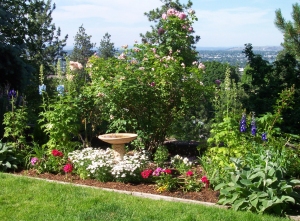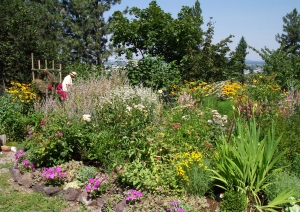| |
Some
14 years ago in Stoke Poges, a village not far from
London’s Heathrow airport, a Quiet Garden opened its
doors for the first time. It offered hospitality to
those seeking somewhere for spiritual refreshment, a
place where people could simply come and be for a day or
part of a day. We did not know it at the time, but this
was the start of something that was to flourish and
spread to many different countries across the world.
This
simple ministry of hospitality and prayer is the vision
of the Rev. Philip Roderick, founder and director of the
Quiet Garden Movement. His vision for centres of
hospitality began to form 18 years earlier when he was
in Wales. It became a reality when, after a period of
sabbatical leave, he shared his dream with students
attending a course entitled Contemplative
Discipleship. Many were looking for ways of going
deeper, of sharing more with one another, of balancing
the tension between their need for stillness and the
demands of everyday life.
| |
 |
| |
|
Philip
mentioned the need for the loan of a house and garden in
which to begin. Very soon, the Cooper family generously
lent their lovely home at Stoke Poges, providing an
ideal context for this new venture. Stoke Park Farm is a
stone’s throw from St. Gile’s Church where Thomas Gray
wrote his Elegy in the Country Churchyard. Philip
named this venture the “Quiet Garden” after a line from
a poem he wrote as a teenager: “a falling flower in a
quiet garden.”
From
this simple beginning, it soon became clear that the
idea of low cost retreats in people’s homes and gardens
could be replicated anywhere in the world. As a
Christian educator, Philip understood the need for the
provision not only of content, but also of a context for
transformation – sacred spaces for faith development,
spiritual nurture and soul friendship. The Quiet Garden
was, and is, a simple and fully grounded way of
responding to the clear message of Jesus, who withdrew
regularly with his closest friends to a quiet place in a
natural setting in order to have the resources to engage
with the world again.
 |
|
| |
|
It was
not long before people began saying “I could do this”
and “I know someone who would really warm to this
vision.” So the word spread, first to the East Coast of
England, then further afield to Kansas, when in 1993
Philip attended the national conference for Spiritual
Directors International. Having asked to speak to
someone about spiritual development in the diocese, he
was put in touch with the University of
Kansas chaplain, who was also the convenor of the spiritual
formation group. Through the chaplain, Philip met Bishop
Bill Smalley, who took the vision to his diocesan
conference two weeks later and announced that they were
going to “have Quiet Gardens in Kansas.” The following
year, a trip was arranged so that Philip could visit the
six Quiet Gardens or potential Quiet Gardens that the
Bishop and his staff had identified in different parts
of the state.
Philip
once described this ministry as “the creative work of
God in which we can share – creating contexts within
which people can rest, receive spiritual nurture or
perhaps rediscover their true path.” There are now some
270 Quiet Gardens around the world, over 40 of which are
spread across 22 states in the United States, from
Washington to Texas, from California to North Carolina.
“By a
garden is meant mystically a place of spiritual repose,
stillness, peace, refreshment, delight,” wrote Cardinal
Newman in the 19th century (Meditations and Devotions,
1893). These are indeed some of the fruits of time spent
in a Quiet Garden, contemplating the beauty of the world
around, be it in a small backyard, a prairie, a vast
forest or a church memorial garden. It is an opportunity
to be attentive, to hear God speaking and to respond, to
leave refreshed and ready to engage with the world
again.
Philip, reflecting in a newsletter (Quiet Places,
Issue No.17, Pentecost 2004) on What is the Point of
Quiet wrote: “At each of our local Quiet Gardens,
individually and corporately, we are being invited to
respond to the voice of the risen Christ who is longing
to make himself heard in the depths of our heart and
through the welcome and teaching at our hearths. It is
when we learn how to submit in attentiveness, in the
music of quietness, to the mystery of God’s presence
that Jesus can, through his Spirit, direct our minds and
hearts and lead us in the path of wisdom.”
Hospitality is at the heart of the Quiet Garden
Movement. As Martha welcomed Jesus to her home (Luke
10:38, NRSV ) and so enabled Mary to sit at his feet, so
this ministry is dependent on the generosity of those
who offer their homes and gardens so that others may
benefit from a time of quiet reflection and teaching on
Christian spirituality.
Jackie Lock
Administrative Director of the Quiet Garden Movement |
|
![]()